
Seven year-old Hass crop
Introduction: The following is a description of an attempt to grow avocados organically, without irrigation, pesticides or fertilizers. Only time will tell whether the venture is foolish. Last season produced the first tiny ‘commercial’ crop, filling one cubic metre bin for packing. As more trees come into production, more problems and setbacks will arise, some worrying, some serious. Under the circumstances, the operation must be treated as an experiment, not a financial investment, however, obviously the hope is for future success and the reward of quality organic produce. Subscribing to Avocados Australia Limited, an invaluable body publishing ‘Talking Avocados’, the magazine of current technology for commercial production, makes me realise that I am perhaps on the lunatic fringe of farming, at the mercy of every known natural setback. On the positive side, having seen, in the area, small neglected plantations run wild for many years, yet still capable of being cropped in a small way, and also garden trees powering on with no TLC or attention of any kind, promised an intermediate regime of careful husbandry to improve the chances of commercial viability without interfering with the health of the trees, the fruit, the soil, or most importantly, the indigenous and introduced bees and other beneficial pollinating insects. 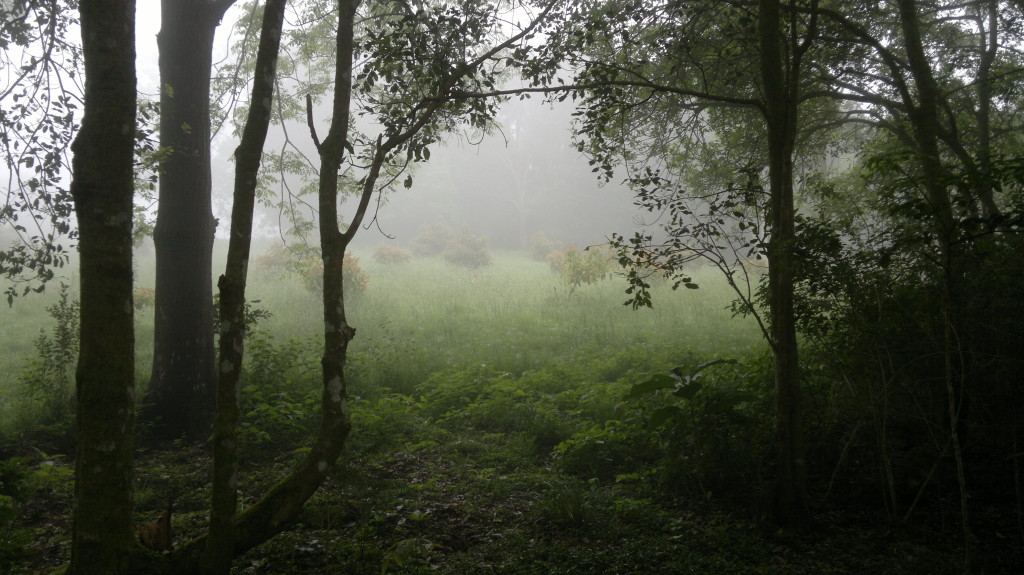
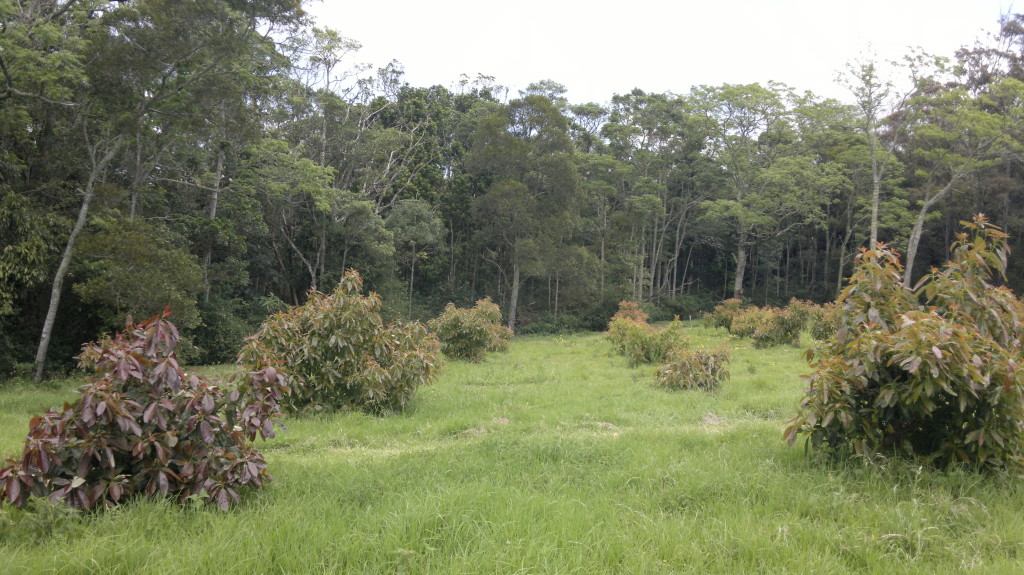 The Area: The plantation is in Ravensbourne, near Toowoomba in Queensland, Australia, an area popular for commercial operations. The site is a hilltop of dense vine-forest at about 800M above sea-level, often mist-shrouded. The trees are in either rows or quincunx, in open clearings and tree-shaded positions. Importantly, virgin forest surrounds the clearings.
The Area: The plantation is in Ravensbourne, near Toowoomba in Queensland, Australia, an area popular for commercial operations. The site is a hilltop of dense vine-forest at about 800M above sea-level, often mist-shrouded. The trees are in either rows or quincunx, in open clearings and tree-shaded positions. Importantly, virgin forest surrounds the clearings.  The Climate: After many years of low rainfall, a decade ago there was a mysterious and welcome change, bringing up to 1500mm annually recently: a tremendous amount. This change cannot be relied on as being permanent, and may revert to past conditions. Since January this year, now March 2014, there has been less than 100mm in what would normally be the wet season. Frost in winter is light but consistent on small exposed areas, temperatures rarely dipping below minus one degree C, or above 38 degrees.
The Climate: After many years of low rainfall, a decade ago there was a mysterious and welcome change, bringing up to 1500mm annually recently: a tremendous amount. This change cannot be relied on as being permanent, and may revert to past conditions. Since January this year, now March 2014, there has been less than 100mm in what would normally be the wet season. Frost in winter is light but consistent on small exposed areas, temperatures rarely dipping below minus one degree C, or above 38 degrees. 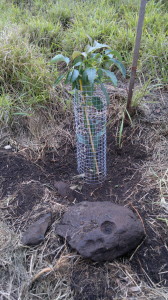
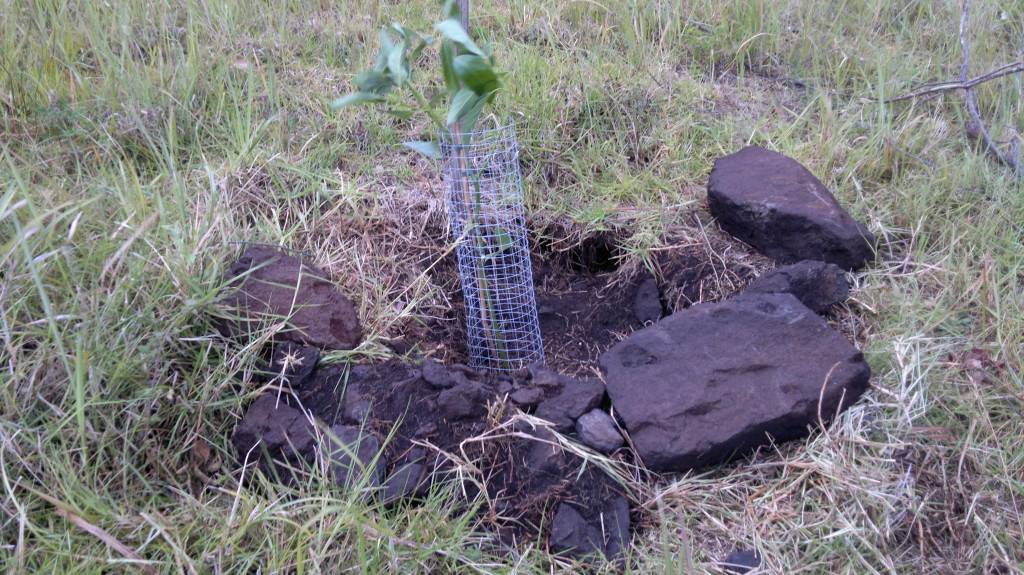 The Soil: Red volcanic loam with widespread basalt bombs of all sizes up to a metre in diameter. Some parts are cluttered with these rounded rocks, others free. On being uncovered the bombs craze, crack, and de-shell over the years. The soil is tough when dry, but soft and easy to dig when moist, and resists compaction by tractor-wheels etc. There is virtually no run-off in all but the heaviest storms, making it a rare event that fills the dam. Rain disappears the instant it hits the ground.
The Soil: Red volcanic loam with widespread basalt bombs of all sizes up to a metre in diameter. Some parts are cluttered with these rounded rocks, others free. On being uncovered the bombs craze, crack, and de-shell over the years. The soil is tough when dry, but soft and easy to dig when moist, and resists compaction by tractor-wheels etc. There is virtually no run-off in all but the heaviest storms, making it a rare event that fills the dam. Rain disappears the instant it hits the ground.  First Plantings: Seven years ago the first grafted plants were put in, mostly Hass. Great liberties were taken with the rules, against all advice from the literature and nursery, and I believe the risks were worth it. Having no irrigation it seemed unwise to plant high on mounds and risk the inevitable dessication by sun and wind, so on the contrary, holes were augered in conical depressions, both to catch rain and to keep roots deep and hopefully in moist ground.
First Plantings: Seven years ago the first grafted plants were put in, mostly Hass. Great liberties were taken with the rules, against all advice from the literature and nursery, and I believe the risks were worth it. Having no irrigation it seemed unwise to plant high on mounds and risk the inevitable dessication by sun and wind, so on the contrary, holes were augered in conical depressions, both to catch rain and to keep roots deep and hopefully in moist ground.  In addition, the nursery potting mix was discarded, and naked roots watered into the native soil with a dilute seaweed solution. The reason for this was a result of plantings becoming dry-stressed within days: the nursery mix, being designed to instantly shed excess water, acted as an insulation preventing absorption from the surrounding soil. This mix is only of use with irrigation, even then there is the danger of waterlogging. The sooner roots penetrate natural ground the better chance of survival. Later plantings compromised the ‘naked root’ system by just giving the de-bagged roots a light wash to expose them to the soil. This has proved successful. Setbacks: All was going well for three years, then frost killed the scions of fifty-odd trees. A few survived, a few died, most sprouted from the rootstock. All attempts to re-graft failed; esoteric knowledge is required, and I don’t have it. New plantings in the frosty areas have survived by the simple technique of having a very scruffy plantation; tall grasses and weeds were allowed to grow up around the little trees. Some top leaves may get burned, but the weeds protect the scions. This fix also had another surprising advantage, during a much more severe setback. Some months after the frost caused the death of those new avos, I was a proud horticulturalist with a model plantation of bowling-green lawns and neat trees tied to supporting posts. Admittedly the weeds were allowed in frosty areas, as a hopeful protection, but nothing prepared me for the shock that happened after a week away. Some time during that week, and only then, hundreds of trees were ring-barked from the ground to 3-400mm up the trunk: most of the plantation at the time.
In addition, the nursery potting mix was discarded, and naked roots watered into the native soil with a dilute seaweed solution. The reason for this was a result of plantings becoming dry-stressed within days: the nursery mix, being designed to instantly shed excess water, acted as an insulation preventing absorption from the surrounding soil. This mix is only of use with irrigation, even then there is the danger of waterlogging. The sooner roots penetrate natural ground the better chance of survival. Later plantings compromised the ‘naked root’ system by just giving the de-bagged roots a light wash to expose them to the soil. This has proved successful. Setbacks: All was going well for three years, then frost killed the scions of fifty-odd trees. A few survived, a few died, most sprouted from the rootstock. All attempts to re-graft failed; esoteric knowledge is required, and I don’t have it. New plantings in the frosty areas have survived by the simple technique of having a very scruffy plantation; tall grasses and weeds were allowed to grow up around the little trees. Some top leaves may get burned, but the weeds protect the scions. This fix also had another surprising advantage, during a much more severe setback. Some months after the frost caused the death of those new avos, I was a proud horticulturalist with a model plantation of bowling-green lawns and neat trees tied to supporting posts. Admittedly the weeds were allowed in frosty areas, as a hopeful protection, but nothing prepared me for the shock that happened after a week away. Some time during that week, and only then, hundreds of trees were ring-barked from the ground to 3-400mm up the trunk: most of the plantation at the time.
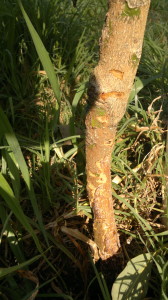
Typical ring-bark of young tree.
Small tooth-marks were obvious, though I never had proof of the actual animals, and there must have been many of them to do such damage. The suspects were rabbits, hares, bandicoots. Rabbits are seldom seen, there are a few hares, surely not enough to get through all that bark, and many bandicoots……but why that one particular week? Possums have stripped young trees from the top down, but not causing more than nuisance damage. Deer? Not yet. Very little further ringbarking has happened since, and new plantings have been protected with wire mesh. A ring-barked tree will take years to die, if the sapwood is undamaged. During that time avocados make desperate efforts to form a bark link from the roots to the undamaged section. Tiny remnants left by the teeth-marks grow and join, and bark grows both down and up the stripped patch. If a link is formed, the tree will eventually survive; if not, there’s no hope, though the rootstock will sprout. About half of the trees died a two-year death. Of the hundreds of thousands of new trees in commercial plantations I have seen none with any protection. Phytophthora: This seems to be a disease of grafted-stock plantations and irrigation, not of wildings or garden trees, and the protection against it the use of phosphoric acid in sprays and hypodermic syringes. Unlike the ring-barking event, phytophthora can kill a small tree stone dead in a few days; a more mature tree takes longer and can therefore be saved. The nurseries are now selling resistant rootstock, but it seems at present the safeguard is regular and constant application of phosphor. I have lost fewer trees to this endemic problem than to other events, and am cautiously ignoring it at present, but am prepared to burst into action. The quick-draining soil and lack of irrigation are working in my favour for the moment, but from week to week the situation could change. Organic disadvantages: Recent plantings have not mollycoddled the young trees; a fatalistic attitude has taken over, but the basic technique has proved itself for the conditions stated previously. The disadvantages of the system are as follows: Trees take a long time to establish, and therefore fruit. Losses and consequent re-planting is wasteful, expensive, and labour-intensive. Wild animals cause damage and loss. Monocultures suffer less. Fruiting may be reduced without artificial support. Organic advantages: Trees develop strong far-reaching roots which act as a buffer to climate change. Soil remains active, mulch breakdown is not hindered by artificial fertilizers. Pollinators from surrounding bush are not endangered Small native birds with nests in the surrounding bush (and in the actual avocado trees) are year-round predators on fruit-spotting insects, and thrive in the un-spoilt conditions. The farmer herself, or himself, has a better, safer, healthier work environment. The fruit of the labour is more valuable in every way. This Plantation: ………..will be ‘In-certification’ later this year, with luck; an expensive operation but necessary to access market distribution in the future, by which time the kindly local packing-shed may have an organic outlet. But, first, the avos. Anything could go wrong. I will keep this site going and would be very keen to hear from any like-growers with information. Being annoyingly self-sufficient I consequently make many unnecessary mistakes and welcome advice.
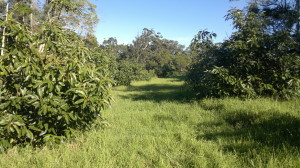
Quincunx of hass
It’s now nearing the end of April and despite the relative lack of rain there is a substantial difference between the photos above and the actual plantation; there has been much growth. Walking and constantly checking for disasters I hadn’t noticed that the things are actually growing. And fruiting. There are good-sized avos on the more mature trees, with three or four months to go. Some of last season’s crop, left hanging by accident, were excellent and rich eating even by March this year. Come July I’m hoping to be ‘in certification’, and able to sell the good stuff………if there is any. Are farmers naturally negative and superstitious? It wouldn’t do to count any chooks.
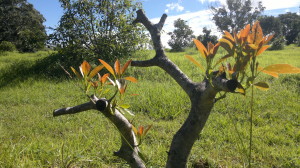
Risen from the dead.
Three stumps like this, assumed to be dead from phytophthera, after six months suddenly sprouted what looks like healthy growth. Absolutely no input from me, no Agrifos.
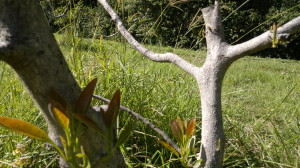
Another resurrection.
This growth in just over a week, in cold weather nearing winter. Strange.
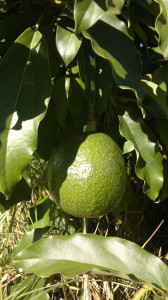
Reed, May 3rd, 2014.
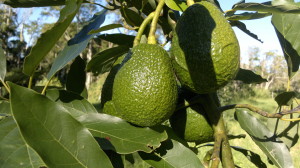
Lamb-Hass, May 3rd, 2014

Pinkerton May 3rd 2014.
I have been picking many varieties recently for home use, and for friends; a few every week to have a ripening supply. It is too early, really; the crop should stay on the tree til at least August or September, but they ripen well, after two or three weeks, and though a bit watery/oily, they are delicious. Today (20th May) I picked a bag of full-sized fruit that may not be ripe for weeks………..in the mean time others are ready. In August, though, the fruit will ripen in 10 to 14 days, without gassing, which is unnecessary.

Guess the cause of the symptom……….
This gum on the plantation looks sad: die-back? Drought? Waterlogging? Storm, lightning, what? I have seen many tall gums looking like this in many parts of Australia, and assumed that drought was the cause, but I was watching when this actually happened. It took ten minutes of hail. The leaves were mostly all still on the tree, but the branches were coated in ice for an hour or so. Over the next weeks the bark began to fall off the affected branches. The leafy branches remaining were on the lea side, and somewhat protected. New growth is very slowly appearing a year after the event. Many tall gums in the area look the same. Interestingly, most of the avos were ok, though many had abraded bark from the hailstones. None died.

Lightning destruction.
This tree really was hit by lightning. It grew on a small ridge that seems to attract strikes, particularly on a neighbour’s place. I have to have special shunts and protectors to safeguard my solar power supply during storms; small devices were constantly failing as thunder-clouds surged overhead. So far
16 June 2014 As a ‘quality control’ exercise I have taken samples of the various varieties in fruit at present. Owing to a number of factors some of the types are uncertain; it was all getting out of control some time ago and my records were getting confused. Failures due to frost, animal ring-barking, phytophthera, unknown causes and the occasional mowing mistake (oh shit) were at various times replaced, mostly by hass, and in a few cases three times. Yes three consecutive plantings in the same position to maintain the plantation; neither practical nor economic. Things have improved since then.
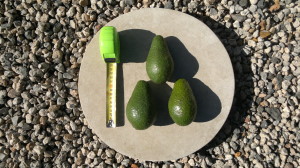
Unsure of this variety at present
On the left are some of the unknown ones; I’ll be able to dig out my original records I hope.

Fuerte
It’s early for picking; judging by last year’s little crop they can be left on the trees for at least three months without deterioration, unless by the weather.
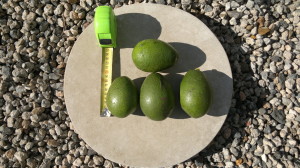
Edranol
Most of the fruit has reached its full size by now. The samples shown will be opened and photographed as they ripen, to check for seed size and wasp damage.

Reed
The reed variety below are in different stages of growth from tree to tree. Whether the smaller fruit will continue to grow through the winter is doubtful. There were wurtz planted in this area, which could be the smaller type.

Lamb-Hass
The lamb-hass were expensive to buy and slow to grow but are doing well. They are bulkier than the hass and I believe have a smaller seed; we’ll see when they ripen. I hate wasting the beautiful fruit by sacrificing for science.
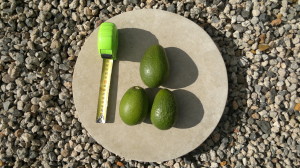
Pinkerton
Pinkertons are not fruiting prolifically, but it is early days for them.

Hass
I’m very interested in the two home-grown varieties below. The hass are looking after themselves and hopefully will look after me, but the Russet look very hopeful. These two avos weigh over half a Kg each, and have a very attractive russet bloom on the sunny side. I suspect that they will be disappointing when ripe, but you never know.
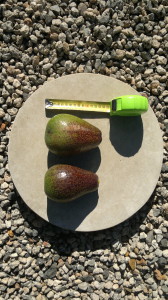
New variety Russet Jenner yet to be tested
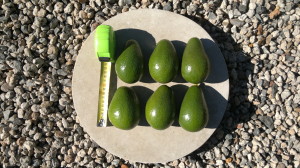
New variety Smooth Jenner yet to be tested
The same goes for these six beauties above. A shape like hass but with an even, glossy smoothness. This is a young tree’s first crop; not one fruit last year, and now it is heavy with hundreds of avos. Dreaming of a successful sport is harmless; like hoping for the winning ticket! All will be revealed in a week or two……..watch this space.

New variety Pear Jenner of doubtful viability, yet to be tested
.These on the left I’m pretty certain are crap; The tree will survive for one more season, then if no good, it’s firewood.
21 June 2014
The Russet wilding (above) picked on the 14th of June ripened today; very quick, too quick to be commercially viable, however, on cutting, there are good points. The skin is firm but not thick, and peels easily, the seed is large but not out of proportion for the size of fruit, and the flesh is pale, smooth and creamy with no sign of stringyness associated with many wildings, and pleasantly nutty. The cut avocado, below, will be compared with the uncut , which I shall leave in its ripening state at room temperature for a few days to assess its keeping qualities. The other wildings ‘Smooth’ are still firm.

Cut ripe Russet
Bearing in mind that the two ‘Russets’ on the left weigh half a kilogram it certainly is a tree worth keeping and perhaps grafting from. It will be very interesting to see how it fares next year, meanwhile I’m waiting for the ‘Smooth’ to ripen for testing; I picked a few, so I can monitor its keeping qualities from picking-to-ripening.
I get to eat them, too. Delicious.
Two thoughts have occurred to me at the plantation. The first concerns the burrows at the base of many avocados; perhaps the digging creatures (rodents, bandicoots?) are eating the roots, causing die-back of parts or all of the tree above, which I have been attributing to phytophthera. How to test this?
Secondly, the recent few days of misty, drizzly grey weather has put but a smidgin in the gauge, at the most 5mm on any day, yet the ground becomes soaked under the tree-cover; a very useful effect: the mist condenses on the leaves and branches and falls in heavy drops, though in the open there is no actual rain. It would be difficult to test without a gauge of 2 or 3 square metres set under the canopy, but I recon the actual rainfall would be two or three times that in the open. The forest is self-maintaining, as will be the plantation.

Ripe Edranol?
25th June 2014: Picked on the 14th (see above) this Edranol is just ripening, which gives it eleven to fourteen days shelf-life from picking, at room temperature. The seed is unsatisfactorily large, possibly this particular tree is inferior, but I would assume the fruit is a wilding if I hadn’t paid good money for the grafted tree.
2nd July 2014 The wilding Smooth pictured below are now just ripening without refrigeration, and are remarkably good, with a very small seed, good tough skin that peels easily, and firm, oily flesh which is not mushy or wet. The tree had a laden first crop which has taken 18 days since picking for the first ripening; others are still firm, so a 20-day period is useful. Below is a photo of the first cut ripe Smooth;
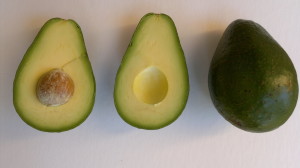
Ripe ‘Smooth’ wilding
11th July 2014
There will be frosts up on the hill; I’ve been away so I don’t know what damage has been done, if any: new trees planted years ago were all lost in frost areas, the graft killed. I hope the replacements are tough enough to cope.
The Lamb-Hass are just ripening; they were picked on the 14th June, nearly a month ago, without refrigeration. I have noticed that these and the Smooth are shrinking slightly on ripening, causing vertical furrowing of the skin, but with no deterioration of the flesh. Perhaps as a result of being picked too early? I’ll see how the ones remaining on the trees behave.
25th August 2014 Getting near picking time. Possibly will be certified Organic soon, which means lots of extra work. The cost has been huge, out of all proportion to the value of the fruit, but I’m thinking of the future…..or am I mad?
13th September 2014 This is a very frustrating period, waiting, waiting, and tying many ends together, and accumulating stuff to tackle the harvest. Time is running out for an ideal picking date, but I’m hoping that the cooler temperatures and elevation will hold the fruit safely for some time yet.
The Certification Organic-In-Conversion has arrived. Two big boxes are ready for the tractor-trailer, total volume 1Cu. M.
Tables ready for bush packing.
Scales and cartons ready.
Labels almost ready.
The distributors at Rocklea have their forms and accreditation posted: no contact from them yet.
Waiting, waiting.
CONTINUES WITH NEWS FROM FEBRUARY 2015
Last year’s work and crop was encouraging; the plantation is now ‘In Certification’, a few more young trees bore their first fruit to add to the small promising total, and the distributors at Rocklea Markets were helpful, praising the quality, and paying me money.
There are still no chemicals of any sort being used for any reason on the trees. I have considered injecting a few sad specimens with phosphoric acid, but am holding off as they seem to be repairing themselves……..an unlikely event, I’ll admit.
Late last year there was no penetrating rain for months, and the new plantings were suffering badly, there being no irrigation. Few were dying, but all were on the point of dying, until finally in December good rain came, and now all are slowly reviving. Commercially this situation is unacceptable, but from my point of view, the trees are becoming very resistant and tough, if slow, and therefore viably productive of organic fruit in the future.
This summer has been unusual, in ways both good and bad and annoying. Good, in that there has been excellent healthy growth of the maturing trees, bad in that I will have virtually no crop this year, and annoying because of the staggering weed growth.
No crop: a hailstorm travelled through, knocking off all the flowers, and scarring the setting fruit, on all varieties, sparing none. No damage was done otherwise, and the trees powered on………but no crop.
Weed growth: I’ve never seen anything like it in previous years. It does no harm, and when mowed produces good green mulch, but this rampant growth overtopped and totally obscured the new and 2-year-old plantings in a very short time, making it a nightmare to clear without mowing down the avos too. Ok, so I was away for a month, but this was ridiculous. Cobbler’s pegs seven feet high, tobacco plants to eight and nine feet, creepers everywhere. If it weren’t for the careful setting-out of the rows I would have had no idea where the bloody trees were.
It used to take three days to mow the entire place; this time I need a fortnight of hard work.
So, there’s all winter to get the place into shape, and wonder what to do with the small, battered crop…..just how many avos can I eat? There will be a tiny amount to sell.
MARCH 2015
The hailstorm mentioned above has certainly cancelled this year’s crop, though the scarred fruit is all growing well. As the fruit gets bigger the scars are relatively smaller:some consolation! But I don’t think they’ll be saleable. Ah well……next year.
 JULY 2015
JULY 2015
Well, here is a branch of the recent crop previously and fancifully called Russet Jenner, ha ha, and they do look beautiful, except for the fact that the hail knocked off most of the setting fruit, including all the other trees.
I have approached Birdwood nursery, where I bought all the stock, to see if they would help, for a price, to make grafts from this tree…….as yet I have had no reply.
As I have mentioned, all previous attempts to graft have failed, and the googled info has no new techniques for accomplishing this. There are secrets to this trade, and wisely so, otherwise everyone would set up shop. Still, one must pay for skill.
JULY 2018 UPDATE ON PLANTATION.
I notice the seasons have been flying past, the poor blog neglected; Acts of God, alias Weather, have set things back financially. Two years running hail has attacked my newly-hatched avos, fresh-formed from the flower, knocking off flowers, buds, tiny fruit, and wounding those that hung on. Nevertheless a couple of tonnes has gone to market at excellent prices……..a situation that cannot last.
Hundreds of thousands of avo trees are being planted in Australia alone; inevitably there will be a glut in the future. Until then, I’m making hay while the sun shines.
My hard and expensive past work is finally starting to earn a bit of money. Bar hail, things would be better, but the trees themselves are fine, and each year more and more are bearing fruit, though it will be a long time before they are all on line.
My picking plan is drastically altered. I now pick the largest fruit from each tree as it reaches a good size, so the harvest looks like being spread over six months or more. Most of the fruiting trees have been picked three times so far, in a relaxed weekly fashion: a day preparing boxes, two days picking, a day packing, a day to market. This is for half a tonne, sometimes less. Flat out, on my own, I can see a tonne a week processed, for a good income at today’s prices. It can’t last.
My last pick was over 500kg a couple of weeks ago. There’s still a lot of small fruit on the trees which I’m hoping (as I write) this marvellous rain will grow to a good size, if it’s not too late: the ground was very dry. So far the new regime has proved ok with the market and with me, spreading the season over months. The habits of different varieties helps too; one huge Reed tree has given four pickings, and more to come. Some varieties are early, some late. Each year more trees bear fruit, a lovely bounty to look forward to for a long time to come.
I was too optimistic with under-story planting; not a good idea. Avos grow to the sun before they fruit. I’m considering getting rid of inter-plantation forest trees, and some on the boundaries; The forest trees of many varieties have grown enormously over the years, out-shading the slow avos.
My yearly expensive ($1500) Organic Certification inspection is done; a necessary outlay while prices are good, but doubtful in the future.
For 2018, despite hail, the work has produced a small income. But. Soon the van and tractor will break down, etc. Ah well. If only the avos will outpace the expences……
UPDATE NEW YEAR 2019-2020
No doubt the news is common knowledge now, though I predicted it in a blog on July 2019. We are in a disastrous drought in Queensland and NSW. Disastrous for all farmers, and for me.
The avos are buggered. This is the fourth consecutive year in which the weather has defeated enterprise; in order: hail, hail, a fortnight of icy cold during flowering and setting of fruit (it all dropped off), and now, the worst of the lot, drought, that is at this moment killing many of my trees and putting the remainder in the balance.
Since long before the setting of the berries no rain has fallen until right now; 60mm last week, which may or may not save many trees. So the picture is of naked leafless trees with tiny 30mm fruit dangling desperately in the wind. These are the best trees; some 100 are dead, totally dried out: mostly the smallest, planted hopefully within the forest enclosures. But the forest has sucked the ground dry.
My recent blogs on ‘Qld. drought’ will explain the situation, and the fact that terrible fires have scourged the country, (and missed my place by two kilometres…….this time). The country has been through similar devastation in the 1890′s, well and tragically described by Henry Lawson in his stories and poetry: an eyewitness of greater impact than all the current tv coverage.
So I fear for my place. All the work of 20 years may come to nothing. The fact that my pond and dam have been dry for over five years should have been a warning. Neighbours are running out of bore-water for irrigation; their trees and crops will go suddenly, when they go. Mine at least have good roots, but time will tell.
Recently I set up my ‘pathetic’ bore. I put it in (over 90 metres deep), cased and equipped, years ago, on a whim, and when I had cash. As a toy, really. But now I realise the thousand litres per hour is a very useful amount should my rainwater tank get low. The bore can be sucked dry after a few thousand, but has always filled the next day, so I got to work and fitted it up with a slab, shed, tank and pump, (the old stationary-engine and antique pump from the ‘dam’), and 150M of pipe to the house-tank. So, there’s water for humans, if not agriculture, and it’s excellent drinking water. I may line the pond, next.
On top of these worries, for the first time I have actually seen a deer grazing on the block; under the fig tree just by the chalet. A doe, though there must be stags too, which have broken-off the tops of a few small trees. What damage will they cause in the future? Will they eat the avo-trees, or the bark off them? Fire must be driving them up here. Also, just a day ago, a dingo by the dam……..so much for the baiting campaign………all fuss, no results, typical bureaucracy.
So, a new year in a day or two. Ravensbourne threatened by drought, fire, deer, possums, dingos, hares and rabbits, and a total loss of the fourth avo crop, and possibly the trees too, as well as the forest, house, and infrastructure if a fire goes through………wonderful.
How strange to read the start of this blog again now. Despite all the problems the plantation was lush and green and fecund, and the thought of drought was laughable in one of the most consistently moist areas of Queensland. No-one could have predicted, or even considered such a change, in such a short time. Tragically, this looks to be a severe step in the drying of our climate, and a permanent one, with no reverting to previous rainfall totals. Time will tell, and blogs.































